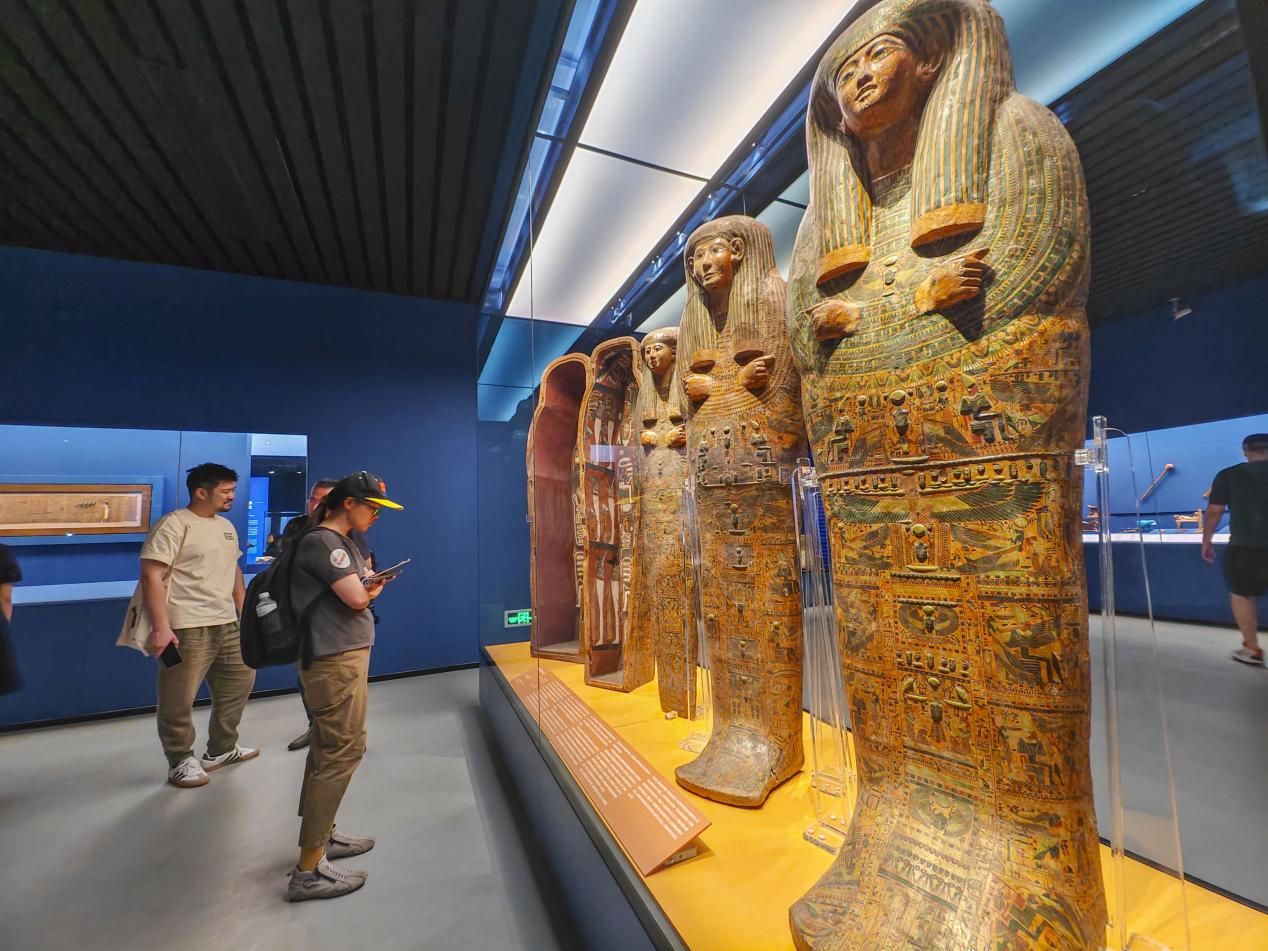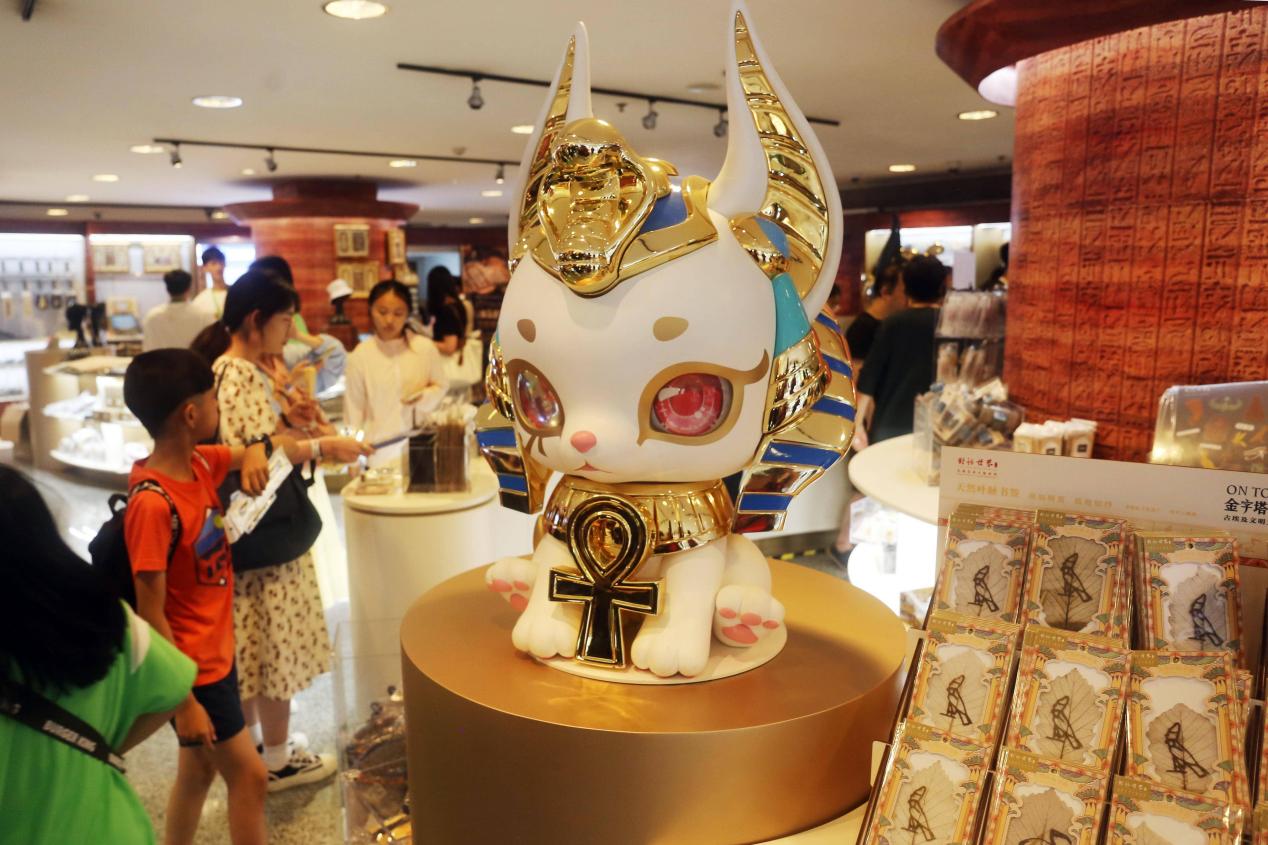




- BRNN
- BRI News
- BRNN News
- Database
Official Documents Polices and Regulations
Inter-government Documents International Cooperation BRI Countries
Business Guide Economic Data BRI Data
Trade
Investment Projects Latest projects
Cases - Content Pool

Visitors wait in lines to enter the Shanghai Museum. (Photo/Wang Chu)
At midnight on Aug. 16, while most of Shanghai had settled into slumber, the plaza at the south gate of the Shanghai Museum on People's Square (Shanghai Museum) was growing ever more animated. A line of visitors stretched across the square. Some had just arrived in the city, their suitcases in tow, joining the crowd streaming toward the entrance.
Since its opening on July 19 last year, the exhibition titled "On Top of the Pyramid: The Civilization of Ancient Egypt" has lasted for 13 months without losing momentum. In its final week, the museum unveiled an unprecedented schedule: seven consecutive days of round-the-clock opening, 168 hours in total. Every night, 3,000 special late-night tickets, valid from 10 p.m. to 6 a.m., were released online and sold out within minutes.
The exhibition ultimately drew 2.77 million visitors, setting a world record for attendance at a single paid special exhibition in any museum.
"We anticipated popularity, but never imagined demand would exceed capacity for over a year," said Chu Xiaobo, director of the Shanghai Museum. To preserve visitor experience quality, the museum extended its closing time to 9 p.m. during peak seasons and added 220 night and special sessions.
"This is my eighth visit," said visitor Li Bo with delight. "The collection's richness reveals new insights each time."
"From the start, the goal was clear: if the museum was going to charge for a special exhibition, it had to deliver a world-class event with global impact," said Li Feng, executive director of the museum's high-quality development task force. In his view, "impact" depends on both the caliber of the artifacts and the standard of curation.

Visitors attend the exhibition titled "On Top of the Pyramid: The Civilization of Ancient Egypt." (Photo/Wang Chu)
That ambition was evident from the start, when a charter plane carried 788 pieces of ancient Egyptian artifacts and documents - organized into 492 groups within 91 crates - from the Nile's banks to Shanghai.
Jointly organized with the Shanghai Museum and Egypt's Supreme Council of Antiquities, the exhibition displayed the largest number of Egyptian artifacts ever shown in Asia. Selected from seven major Egyptian museums, including the Grand Egyptian Museum, the Luxor Museum, and the Suez Museum, the collection also featured recent discoveries from joint Chinese-Egyptian archaeological teams.
Remarkably, more than 95 percent of the artifacts were on view in Asia for the first time, and several finds from Saqqara made their global debut in Shanghai.
Inside the gallery themed "The Age of Tutankhamun," walls bathed in blue and yellow suggested the meeting of ocean and desert, producing a striking visual effect. Visitors crowded around the colossal statue of Akhenaten, one of the exhibition's most photographed highlights, eager to capture a "dialogue across time."
In another gallery, "The Secrets of Saqqara," visitor Wang Xiaoxiang lingered before a cat sculpture. "It's in such perfect condition," Wang said. "It's not just the charm of the animal, but also the gentleness in its expression. It feels almost magical."
Last summer, the museum complemented the exhibition with ten "Fantastic Night" events, even allowing visitors to bring their cats. This year's 168-hour marathon opening also featured two carnival-style nights, with Egyptian drumming, traditional dance, acrobatics, and musical theater.

Visitors buy cultural and creative products themed with the "On Top of the Pyramid: The Civilization of Ancient Egypt" exhibition at the Shanghai Museum. (Photo/Chen Yuyu)
The exhibition's influence generated significant cultural and economic ripple effects far beyond its gallery walls.
Cultural products: Drawing inspiration from nearly 100 highlight objects, the museum developed over 1,200 cultural and creative products, selling more than 3 million items. Nearly 500 related events attracted close to 300,000 participants.
Public programs: The museum hosted more than 10 themed lectures, including one by Mohamed Ismail Khaled, secretary-general of Egypt's Supreme Council of Antiquities, on Egypt's latest archaeological discoveries, and another by Peking University professor Yan Haiying on daily life in ancient Egypt. More than 6,000 in-person activities, such as public lectures, art workshops, and community events, drew nearly 1.4 million participants in total.
Cross-sector collaboration: The museum built a full cultural tourism ecosystem around the exhibition, including a themed cruise, shuttle buses decorated with Egyptian motifs, and even a jet painted with the Shanghai Museum's name and logo. Joint initiatives with commercial districts and enterprises helped integrate culture, tourism, business, and sports experiences, amplifying the exhibition's impact across local retail, hospitality, and entertainment sectors.
To sustain operations during the 168-hour marathon, the museum mobilized robust support measures, with security, cleaning, and medical teams working in shifts around the clock. "What struck me most was an elderly visitor, over 80 years old, who still came late at night just to see the artifacts," said Zhou Yanjing, a museum staff member. "When you witness such passion from the public, every effort feels worthwhile."
On the evening of Aug. 17, after nearly 400 days and nights, the landmark exhibition came to a close. Yet the museum's dialogue with world civilizations continues. Guided by a spirit of openness and inclusiveness, the Shanghai Museum will press ahead with global cultural exchanges, and more exhibitions of similar magnitude are sure to follow.

Tel:86-10-65363107, 86-10-65368220, 86-10-65363106